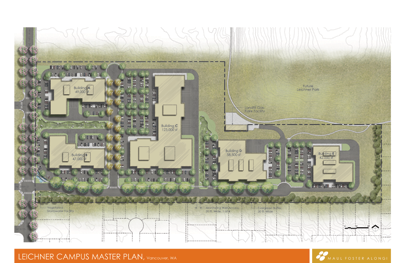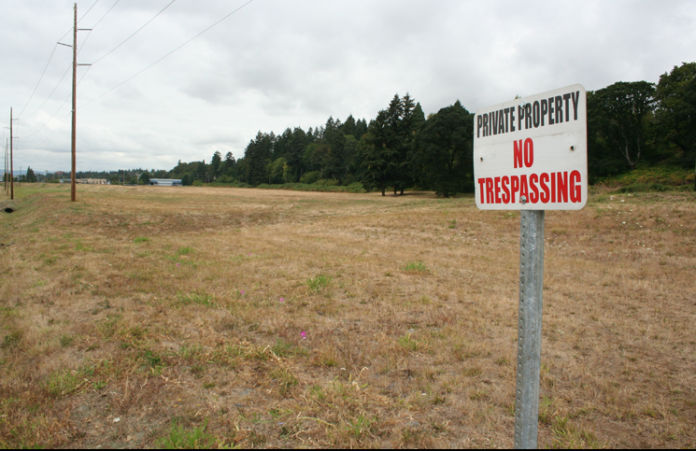Several development projects in Clark County underscore the growing willingness of the development community – including lenders – to take on “brownfields.” A brownfield is an abandoned or underused property where there may be environmental contamination.
“Developers are becoming more familiar with the risks and how to mitigate them, the engineering community is becoming more savvy and lending institutions are more willing to lend on properties with environmental constraints,” said Mark Leece, principal engineer with PBS Engineering and Environmental Inc.
Two such projects bookend Clark County.
Landfill redevelopment
Recently, the county initiated the master plan for the Leichner Landfill property in central north county. Closed for over a decade and purchased by the County about four years ago, the site will include 35 acres of development plus green space and areas reserved for future right-of-way development.
“We’ve been working on the plan for three years,” said Seth Otto, master planner for Maul Foster & Alongi Inc. (MFA), a Vancouver-based environmental engineering firm. “It will be a catalyst for further expansion and development of industrial land in that part of the county.”
The County expects to have approval and begin marketing the property by early 2017.
Lower Grand Employment Area
In March 2016, the city of Vancouver completed an action plan for improving conditions for existing and new primarily industrial businesses in the Lower Grand Employment Area, a prior Superfund site immediately east of Pearson Air Field and north of SR-14 that has languished and remained vacant for considerable time. Maul Foster & Alongi was the lead contractor for the study, helping to identify infrastructure deficiencies and missed business opportunities, as well as the impact of brownfield issues. Otto said the process was a public/private partnership that benefits the entire area and will facilitate expansion of employers located there.
Both these projects, along with other familiar projects such as the Waterfront Vancouver development project, the Port of Camas/Washougal’s transformation of the legacy Hambleton Lumber property, the Port of Ridgefield’s waterfront project and the Port of Vancouver’s Terminal 1 project, underscore new trends in brownfield development.
“Brownfield development is being driven by high demand for large-lot industrial and employment land,” said Otto. “These projects are good examples of public sector investment paving the way for private investment.”
A new generation of brownfield development
Historically, brownfield redevelopment efforts have been hindered by the liability for the cleanup or the uncertainty of cleanup costs. In the 1980s, unless the regulatory “big guns” came out, developers would seek opportunities elsewhere. This “first generation,” said Jim Maul, MFA president and principal hydrogeologist, did not consider economics at all.
By the 1990s, explained Maul, developers began to realize that remedies (such as capping a contaminated area) could become part of the development. Project economics began to be part of the equation. As the 21st century dawned, brownfield development began to consider community benefit, where cleanup and reuse became associated an increased tax base, area revitalization and/or community pride.
Now, said Maul, we’re in the fourth generation. Although the implementation of federal and state regulations have sparked cleanup of the worst sites, there are still thousands of contaminated properties. Instead of being driven by regulatory forces, cleanup is now being driven by market forces.

“Properties are valuable when they are redeveloped – the development becomes the remedy,” said Maul.
“The industry has gone from an early stage of ‘we have to clean up everything regardless of financial considerations’ to a more moderate approach,” noted Eric Hovee, principal of ED Hovee & Co. LLC, a Vancouver-based economic development consulting service. “There’s more attention being paid to understanding what types of remediation and property reuse make the most sense. The economic side of the equation is getting more attention.”
Hovee said his firm has developed a sophisticated financial modeling program (also used by the Washington state department of Ecology on occasion) that can help take some of the financial uncertainty out of developing a brownfield.
Start with end in mind
Otto stressed that to make the “economic equation” balance, developers must “find the right use and the right user, and channel partnerships” because the specific property use can drive the type and level of cleanup necessary.
Leece said “one of my passions is to evaluate a site, characterize it, do a feasibility study, then decide how cleanup will be incorporated into the development.” He gave a couple examples, such as designing a vapor mitigation system that could be incorporated into a building without additional cost, and using excavated subsoil that is “not pristine” as foundational material for pads and roadways (which serve to compress and cap any contaminants that exist).
Hovee gave another example – the amount of soil contamination can shape the resulting buildings. Low-rise construction might not have problems, but a six- to 10-story building would need a deeper foundation which would require more work to protect the site during construction against airborne particles and long-term effects of gases and volatile chemicals.
“The real opportunity is incorporating the endgame early in the process,” said Leece, “because the approach to mediation differs depending on the end use. For example, creating a barrier may be more cost effective than removal.”
Don’t be intimidated
Brownfield sites that aren’t cleaned up represent lost opportunities for economic development and for other community improvements. As urban infill becomes more intense and “greenfield” property becomes more scarce, brownfield properties will continue to be more attractive as development projects, said Leece. Maul emphasized that property owners and developers shouldn’t be intimidated by brownfields, and should look to partner with the city of Vancouver and Clark County, which are both taking an active role and making resources available.
“Grasp the opportunity and help meet the demand for land,” said Maul.
Right resources are key to brownfield success
Brownfield property owners and potential developers shouldn’t feel like they have to “go it alone” – there are lots of resources available to help with planning and cleanup.
“It’s important to realize that the mere presence of contamination doesn’t mean a property can’t be developed effectively. There are lots of programs to help with that – cleanup is not a dead end,” said Jim Maul, Maul Foster & Alongi Inc. president and principal hydrogeologist.
Mark Leece, principal engineer with PBS Engineering and Environmental Inc., added that is crucial to find an engineering team that has experience with design of both environmental issues and the actual project.
“The more a property owner can hook up with a good team, the more resources will be available,” said Eric Hovee, principal of ED Hovee & Co. LLC. “Look for a good track record for these types of developments. Maul Foster and PBS are prime examples.”
The following list of links is just a taste of available resources:
- EPA Region 10 Brownfields website
- US EPA Area-Wide Planning Grant
- Summary of Brownfields Funding in Washington State
- Brownfields Integrated Planning Grants
- Remedial Action Grants and Loans
- Environmental Finance Center Network
- The Department of Commerce (Brownfields Revolving Loan Fund and technical assistance)
- Revitalizing contaminated property for reuse
- Brownfields Revitalization Program (Washington State Department of Ecology)
- Brownfields Resource Guide Assistance for Redevelopment in Washington State
- Brownfields Online Library
- Model Toxics Control Act Remedial Action Grants – Alternative Financing Evaluation
- Petroleum Brownfields: Selecting a Reuse Option
- SMARTe (Evaluate future use scenarios and other resources for revitalization)
- A Guide to Federal Tax Incentives for Brownfields Redevelopment
- Road Map to Understanding Innovative Technology Options for Brownfields Investigation and Cleanup
- Getting Started with Brownfields — Key Issues and Opportunities: What Communities Need to Know
- Brownfield/Greenfield Life Cycle Comparison Tool





